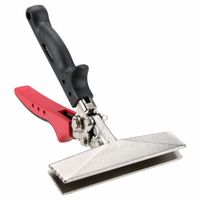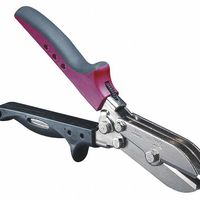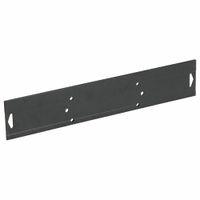Call +(254) 703 030 000 / 751 483 999 / 721 704 777
- Home
- Tools
- Hand Tools
- Sheet Metal Folders Crimpers
.....Read More
Frequently Asked Questions
What is the difference between a sheet metal folder and a crimper?
A sheet metal folder and a crimper are both tools used in metalworking, but they serve different purposes and operate differently.
A sheet metal folder, also known as a brake, is a tool used to bend sheet metal into desired angles and shapes. It consists of a flat surface where the metal is placed and a clamping bar that holds the metal in place. The operator lifts a bending leaf to fold the metal along a straight line. Folders are used for creating precise bends and folds, making them essential for fabricating items like boxes, panels, and ducts. They come in various types, including manual, hydraulic, and CNC-operated, allowing for different levels of precision and automation.
On the other hand, a crimper is a tool used to join two pieces of metal by deforming one or both to hold them together. Crimping involves compressing the metal to create a tight seal or connection, often used in ductwork, roofing, and electrical applications. Crimpers can be manual or powered and are designed to create a series of small, uniform indentations or crimps along the edge of the metal. This process is crucial for ensuring airtight and watertight seals in HVAC systems and other applications where secure connections are necessary.
In summary, the primary difference lies in their functions: a sheet metal folder is used for bending and shaping metal, while a crimper is used for joining and sealing metal pieces. Each tool is essential in its respective applications, contributing to the versatility and functionality of metalworking processes.
How do you use a hand seamer for sheet metal?
To use a hand seamer for sheet metal, follow these steps:
1. **Select the Right Seamer**: Choose a hand seamer with the appropriate jaw width and depth for your specific project needs.
2. **Prepare the Sheet Metal**: Ensure the sheet metal is clean and free of debris. Mark the bend line clearly using a scribe or marker.
3. **Position the Seamer**: Align the jaws of the hand seamer with the marked bend line on the sheet metal. Ensure the jaws are parallel to the line for an even bend.
4. **Secure the Metal**: Firmly grip the handles of the seamer to clamp the sheet metal between the jaws. Ensure the metal is securely held to prevent slipping during bending.
5. **Bend the Metal**: Apply steady pressure to the handles to begin bending the metal. For a sharper bend, apply more force. For a gradual bend, apply less force and bend incrementally.
6. **Check the Angle**: Release the seamer and check the angle of the bend. If further bending is needed, reposition the seamer slightly along the bend line and repeat the process.
7. **Adjust as Necessary**: For precise angles, use a protractor or angle gauge to measure the bend. Make any necessary adjustments by reapplying the seamer and bending further.
8. **Finish the Bend**: Once the desired angle is achieved, run the seamer along the entire length of the bend to ensure uniformity.
9. **Inspect the Work**: Check the bend for any irregularities or imperfections. Make any final adjustments as needed.
10. **Clean Up**: Wipe down the seamer and the sheet metal to remove any residue or markings.
By following these steps, you can effectively use a hand seamer to create precise bends in sheet metal for various applications.
What are the best tools for bending sheet metal?
The best tools for bending sheet metal include:
1. **Press Brake**: Ideal for precise and large-scale bending, press brakes use a punch and die to form metal. They are available in hydraulic, mechanical, and CNC versions, offering versatility and accuracy.
2. **Sheet Metal Brake**: Also known as a bending brake, this tool is perfect for making straight bends and creases. It is commonly used for smaller projects and is available in manual, hydraulic, and electric models.
3. **Roll Bender**: Used for creating curves and cylindrical shapes, roll benders have three rollers that gradually shape the metal. They are suitable for both small and large-scale operations.
4. **Hand Seamer**: A portable tool for making precise, small bends and folds, hand seamers are ideal for on-site adjustments and small projects.
5. **Slip Roll Machine**: This tool is used for rolling sheet metal into curves and cylinders. It is particularly useful for creating consistent, smooth bends.
6. **English Wheel**: Primarily used for shaping and smoothing compound curves, the English wheel is essential for custom and intricate metalwork.
7. **Power Hammer**: For shaping and forming metal with repeated hammering, power hammers are efficient for complex and large-scale projects.
8. **Hydraulic Bender**: Suitable for heavy-duty bending tasks, hydraulic benders provide the force needed for thick and tough metals.
9. **Vise and Hammer**: For simple and small-scale bending tasks, a vise and hammer can be used to manually shape metal.
10. **Tube Bender**: Specifically designed for bending tubes and pipes, tube benders ensure smooth, kink-free curves.
Each tool has its specific applications, and the choice depends on the project requirements, material thickness, and desired precision.
How do you maintain sheet metal folding tools?
To maintain sheet metal folding tools effectively, follow these steps:
1. **Regular Cleaning**: After each use, clean the tools to remove metal shavings, dust, and debris. Use a soft brush or cloth to prevent scratches.
2. **Lubrication**: Apply a light machine oil or a specialized lubricant to moving parts to ensure smooth operation and prevent rust. Focus on hinges, joints, and any sliding components.
3. **Inspection**: Regularly inspect the tools for signs of wear, damage, or misalignment. Check for cracks, bends, or any deformation that could affect performance.
4. **Sharpening**: If the tools have cutting edges, ensure they are sharp. Use a sharpening stone or file as needed, following the manufacturer's guidelines.
5. **Alignment**: Ensure that all parts are properly aligned. Misalignment can lead to inaccurate folds and increased wear on the tool.
6. **Storage**: Store tools in a dry, clean environment to prevent rust and corrosion. Use protective covers or cases to shield them from dust and moisture.
7. **Calibration**: Periodically calibrate the tools to ensure precision in folding. Follow the manufacturer's instructions for calibration procedures.
8. **Replacement of Worn Parts**: Replace any worn or damaged parts promptly to maintain tool efficiency and safety.
9. **Training**: Ensure that all operators are trained in the correct use and maintenance of the tools to prevent misuse and extend their lifespan.
10. **Documentation**: Keep a maintenance log to track cleaning, lubrication, inspections, and any repairs or replacements. This helps in scheduling regular maintenance and identifying recurring issues.
By adhering to these maintenance practices, you can extend the life of sheet metal folding tools and ensure consistent, high-quality results.
What are the common applications of sheet metal crimpers?
Sheet metal crimpers are versatile tools used in various industries for joining and securing metal sheets. Common applications include:
1. **HVAC Systems**: Crimpers are essential in the HVAC industry for connecting ductwork. They create secure, leak-proof joints between sections of metal ducting, ensuring efficient airflow and energy conservation.
2. **Roofing and Guttering**: In roofing, crimpers are used to join metal panels and secure seams, providing weather-tight seals. They are also employed in gutter installation to connect sections and ensure proper water drainage.
3. **Automotive Industry**: Crimpers are used in automotive manufacturing and repair to join metal panels and components. They help in forming strong, durable connections that withstand vibrations and stress.
4. **Electrical Enclosures**: In electrical applications, crimpers are used to assemble metal enclosures and cabinets, ensuring that they are securely fastened and provide adequate protection for electrical components.
5. **Metal Fabrication**: Crimpers are widely used in metal fabrication shops for creating joints in various metal projects, from custom metalwork to large-scale industrial applications.
6. **Aerospace and Aviation**: In these industries, crimpers are used to join lightweight metal components, ensuring structural integrity while maintaining weight efficiency.
7. **Plumbing**: Crimpers are used to connect metal pipes and fittings, ensuring leak-proof joints in plumbing systems.
8. **Construction**: In construction, crimpers are used for assembling metal frameworks and structures, providing stability and strength to buildings and infrastructure.
9. **Agricultural Equipment**: Crimpers are used in the assembly and repair of metal parts in agricultural machinery, ensuring durability and reliability in harsh working conditions.
10. **Signage and Display**: Crimpers are used to assemble metal frames and supports for signs and displays, ensuring they are sturdy and long-lasting.
How do you choose the right sheet metal tool for HVAC ductwork?
Choosing the right sheet metal tool for HVAC ductwork involves several considerations to ensure efficiency, precision, and safety. First, assess the specific tasks required, such as cutting, bending, or joining. For cutting, tools like tin snips, aviation snips, or electric shears are essential, with the choice depending on the thickness and type of metal. For bending, a brake or a hand seamer is necessary, with a brake being ideal for larger, more precise bends.
Consider the material type and thickness, as different metals and gauges require specific tools. For instance, heavier gauges might necessitate power tools, while lighter gauges can be managed with manual tools. Evaluate the complexity of the ductwork design; intricate designs may require more specialized tools like a notcher or a crimper.
Safety is paramount, so choose tools with ergonomic designs to reduce strain and those that include safety features like guards or locks. The tool's durability and maintenance requirements should also be considered, as high-quality, low-maintenance tools can save time and costs in the long run.
Budget constraints are another factor; while investing in high-quality tools can be cost-effective over time, ensure they align with your financial limits. Additionally, consider the tool's compatibility with existing equipment to avoid unnecessary purchases.
Finally, seek recommendations from industry professionals or consult with suppliers to ensure the tools meet industry standards and are suitable for your specific HVAC ductwork needs.
What safety precautions should be taken when using sheet metal tools?
When using sheet metal tools, several safety precautions are essential to prevent accidents and injuries:
1. **Personal Protective Equipment (PPE):** Always wear appropriate PPE, including safety goggles to protect eyes from flying debris, gloves to prevent cuts, and steel-toed boots to protect feet from heavy metal sheets.
2. **Proper Training:** Ensure that all operators are adequately trained in the use of specific sheet metal tools and understand the potential hazards associated with them.
3. **Machine Guards:** Use machine guards on equipment like shears, presses, and brakes to prevent accidental contact with moving parts.
4. **Tool Maintenance:** Regularly inspect and maintain tools to ensure they are in good working condition. Dull blades or malfunctioning equipment can lead to accidents.
5. **Secure Work Area:** Keep the work area clean and organized. Ensure that all tools and materials are stored properly to prevent tripping hazards.
6. **Correct Tool Usage:** Use the right tool for the job and ensure it is used correctly. Improper use can lead to tool damage and personal injury.
7. **Handling Techniques:** Use proper lifting techniques when handling heavy sheets to avoid back injuries. Utilize mechanical aids or seek assistance for heavy or awkward loads.
8. **Awareness of Surroundings:** Be aware of your surroundings and the activities of others in the area to avoid collisions and other accidents.
9. **Emergency Procedures:** Familiarize yourself with emergency procedures, including the location of first aid kits and emergency exits.
10. **Ventilation:** Ensure adequate ventilation when working with sheet metal to avoid inhaling dust or fumes, especially when cutting or welding.
11. **Lockout/Tagout Procedures:** Follow lockout/tagout procedures to ensure machines are properly shut off and cannot be started accidentally during maintenance or repair.
By adhering to these safety precautions, the risk of accidents and injuries when using sheet metal tools can be significantly reduced.


